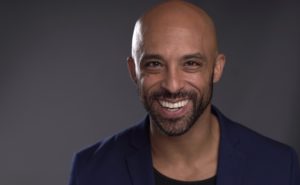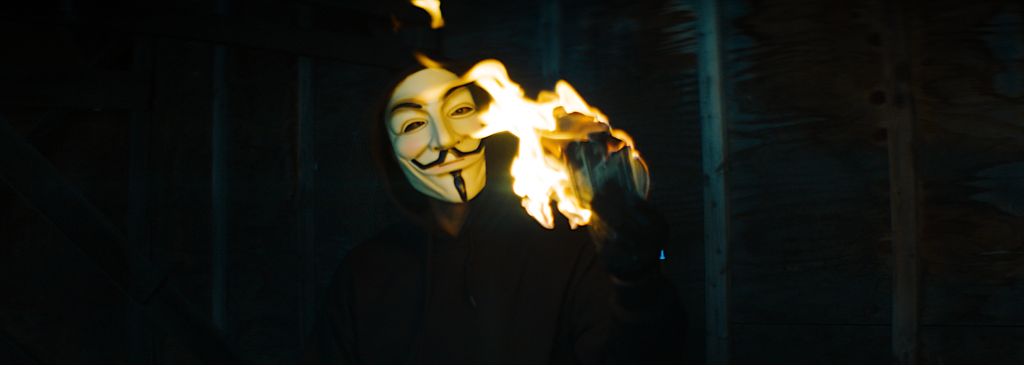Welcome to my latest series for WTF where I’ll be highlighting some of my favourite artists in the NFT space in IRL and Virtual interviews surrounding various industry events. Today I’m joined with the incredible David Bianchi; a multidisciplinary artist paving the way for the film industry to enter NFT Land. So without further ado, I’ll let you watch or read my interview with David Below:
David Cash: Hello NFTs.WTF audience. My name is David Cash, Editor in Chief, and we are here in New York City for NFT.NYC 2021 with the one and only David Bianchi. David, how are you doing today?
David Bianchi: I’m great, man, super excited to be here! I mean, look at us; we’re at the top of the world! We’re here celebrating NFTs that are changing the world, and I’m super happy to be here at the top of New York City and supporting NTFS.WTF.
DC: Thank you, it’s an absolute pleasure to have you here. So being a DAO-backed publication, we’re very much in this decentralized realm. I know you also come from the traditional domain, and now you have broken into this NFT space, super hardcore. What got you started in here, and what excited you about this whole decentralized aspect of the space?
DB: Many people know me as an actor, an independent filmmaker, and a globally known spoken word poet, and I’ve been involved in cryptocurrency since late 2017. So, I understood the underlying technology, the blockchain. But when Beeple sold for 69 million at Christie’s, everybody paid attention, at least anybody involved in crypto. So I started to look at the space during the pandemic, and I was trying to find a new way to invigorate my creativity. Hollywood was relatively dormant, and I’ve been producing high-concept spoken word films for about 17 years, and so our genre that I created is called Spinema, spinning cinema through spoken word. I hold the trademark to that, so watch out you guys.
DC: You heard it here first!

DB: I poked around and found that the struggle in the space is that most of the on-chain megabyte capacities are significantly lower than what I’m used to working with. Because working in a visual medium, I’m used to larger file sizes. Most places at the time were 50 megabytes, and, as an artist, I wanted to enter the space doing what I do best, which to me is Spinema—being a poet, being a filmmaker, being a writer, being on camera, and talking about socially conscious issues. So I ended up finding a platform that allowed for 250 megabytes on-chain. I minted the first award-winning spoken word film as an NFT called “I Can’t Breathe.”
DC: Beautiful and super full-circle moment; of course, you went from being inspired by Beeple to, last night, getting some selfies with Beeple. I mean, here we are in New York, absolutely fulfilling journeys and turning things around.
DB: It’s a super fulfilling journey. I had a great conversation with Beeple, and we spoke for a while. I showed him the teaser trailer for The Revolution Is Being Televised. We’ll talk about that shortly. He watched the trailer and looked at me, and said, “That’s cool. I’ve never seen that before.”
DC: That’s the best thing you could ask for.
DB: For the goat to say, “I’ve never seen that before”, to me, was not only refreshing, but it gave me a sense that I’m on the right path, right? Because nobody’s doing what I’m doing in the NFT space related to NFT and crypto art. So it’s fascinating to hear directly from him, knowing that he, arguably the most important crypto artist in the universe, said that what I’m creating is compelling, sophisticated and something he hasn’t come across before; it meant a lot!
DC: That’s incredible, congratulations. I want to talk a lot about your upcoming collection and the many things happening here in New York that you’re launching. But first, is that you came from an acting background. Still, being that you’re so multidisciplinary and have been for so long, what excites you about this space because I feel finally, us multidisciplinary artists have a place to exist. Where you can be an actor, filmmaker, producer, be taken seriously for it, and sell that work for a lot of money. So tell us about that journey and how you’ve been able to be your true self.
DB: I mean, isn’t it exciting to be an artist and be taken seriously, right? I mean, what a novel idea, right? I made my first painting when I was in second grade. My mother still has it framed. So I’ve been an artist my entire life, and I’ve been a poet my entire life. I came to Hollywood in 2004 and got my sag card and did extra work. I lived on an air mattress with cockroaches in the kitchen. I remember I didn’t have a blanket. I used to lay on an air mattress and put on three shirts, two pairs of pants and a bunch of my used clothes in a ball and I slept like this on a floor in Silver Lake. For 17 years working as an actor, being a waiter and a bartender for easily a decade and a half, cutting my teeth as an actor, getting to the recurring guests’ star level and getting the credits in studio films, etc. It’s a very, very challenging hustle that I never set out not to win that game. But when the NFT space embraced my work and sort of propelled me to the blue-chip level, it’s like, this is something that makes my heart pump. It gives me the rise of inspiration that I haven’t experienced in Hollywood, probably since I first showed up. Where I feel I’m not only creating art that is important and impacting the world. I feel a sense of belonging. I don’t see that there’s a ceiling and I believe that the blockchain and NFT art are limitless.
DC: Absolutely. Especially coming from poetry, some of these mediums that have been very much overlooked over the past decade or two. Now you can be taken seriously and make money as a poet and do the different specific things that you enjoy and are passionate about. I think it’s so exciting in the space if you take it and run with it, and it’s high quality, and you believe in it, people will follow that and people will be attracted to that and I think you’re a testament to that in the space. So, congratulations.

DB: I appreciate that. You’re right that being a self-sufficient artist is what we all fight for, right? That’s what every actor, that’s what every musician, that’s what every muralist, and every street artist wants. You want to be able to be self-sustaining. That’s precisely what NFTs in the blockchain offer the artist, which is passive income, residual income, which is how actors survive. You were a child actor; you’re aware of how that works. Now, artists can earn equity and perpetuity through the assets that they create, through their intellectual property. So for the first time in human history, we’re monetizing ideas and controlling those ideas at the source without an intermediary to take commission or tell us what we should or shouldn’t do. The reason I’m so inspired is what you just alluded to, which is my signature as an artist, being a Spinema artist, I am identified, and I am embraced for what my signature is and that’s what we want. So I invite any artists, this is my call to action to you, if you don’t believe you can do it, get out of your way and get started. Because if you think that you can, you absolutely can because this blockchain is available for you, and it’s available for anybody who wants it. So don’t wait. Don’t go half in. Go all in and get it done.
DC: Amen. I love that. Coming from LA and coming from Hollywood, you have also worked in traditional media for some time. How do you feel that industry will be affected over the next few years? Artists needed a new way to monetize the gallery system. Which has never has been changed. Since the 1800s, the Art Gallery system has remained more or less the same. Then music was kind of a logical next step, and we now see music companies coming in because they already had royalties so that they could justify it. We also see sports and other people who’ve sold tickets. Everybody has their link in. But I feel you’re one of the first people to push cinema into this space. But how did that start for you? I know you’ve been doing spinema for a long time. Also, how do you see things getting maybe longer form because I don’t know many people doing that in this space if anybody. So how do you see the next, maybe five years panning out in terms of the film industry?
DB: Well, I think it’s a, I think it’s a layered question. But, I am pretty singular as it relates to the NFT art that I’m creating. There’s nobody in the ecosystem that’s creating sort of super high concept, cinematic, socially conscious work or any spoken word poets that are doing things at a very, very high level like I am. There are a couple of other poets that are sort of coming in, I hope that I can inspire them so they can follow my footsteps and sort of doing what I’m currently doing right now. Spinema, just so anybody knows, these aren’t poems that are shot with an iPhone, these are treated high-level theatrical experiences. We have 15, 20, 30 person crews, we shoot on an Alexis, we shoot on Reds, I enlist award-winning cinematographers. These are beautifully scored sound designs, so I treat them as theatrical pictures, right? So the bar is pretty high for anybody that’s following me. But, to get to your question about cinema and me sort of penetrating the NFT space with a cinema, for lack of a sexual metaphor. It’s terrifying but also really exhilarating. I just said this on Twitter the other day, that “trailblazing is terrifying, and it’s really, really hard. But it’s not anyone’s perceptions by which I identify”, right? I have to do what my heart tells me to do and forge through and create a path, and I’m happy to take that role and that responsibility because I know that intrinsically I’m built for it. You know we really connected you and I on “break the bars,” which is my last spinema drop which is on Makersplace, and that piece was the first-ever film to have a red carpet premiere in all of the metaverse in Decentraland, we had almost 2000 people attend with POAPs, and it is currently a solo exhibit at the Makersplace gallery in Decentraland, the Volter district. So it’s exciting to see cinema coming to the blockchain. What I’m trying to do at an independent level, I believe that the blockchain will create a new mini-major for Hollywood. If we look at the 90s, Focus Features, Miramax and these sorts of smaller mini-majors back then, they kind of changed the Hollywood landscape and I believe that we are the new mini-major than that we’re going to give Hollywood a run for their money. As the technology evolves and we have higher capacities on-chain, that’s only going to open up the doors for more opportunities for us and you to come in as filmmakers. Once we can get a gigabyte on-chain, and I believe that that day is coming soon, there is going to be a day where cinema will explode from an NFT art perspective, but also long-form, from a nuanced art perspective, I think is going to be king. White-Glove collectors, I believe, will find more value in long-form NFTs than they will in a static image or short format Ntfs. I think that artists, especially 4d, cinema, render artists, 3d Cinema render artists, will want to be more expansive when they have more megabytes to work with.
DC: Because right now, it would take people, days weeks to export something more than a few seconds longer if it’s a high-end 3d image and I think, coming again, from cinema, it’s interesting to see the parallel between the evolution of the initial video technology, and now the evolution of being able to store that on-chain, because it used to be films could only be 10 minutes long, six minutes long, because the film reel would run out, and they had minimal capacity. But now we see that being perpetuated through digital media I think as we saw, the innovative people who took shorter form cinema, in the initial days, in France and these innovators, I think we see a new resurgence of that now with you and people taking short form cinema-like cinematic premises and bring it into the blockchain. So yeah, speaking of I mean, please.
DB: And I want to also preface for anybody out there because people can be very puristic as it relates to art, crypto art, well, crypto art has to be a gift. Crypto art has to be a JPEG. Well, I mean, crypto art, to me, is anything that is sealed in a digital format and then concreted on the blockchain that makes crypto art. I believe that cinema, as we know it today, is probably one of the highest forms of digital art because we’re not shooting cellular. So there’s nothing analog about the filmmaking process, right?
DC: It’s purely digital.
DB: Everything is purely digital, from how we capture it. Even how we storyboard it nowadays is very, not even pencil scratches anymore.
DC: It’s on some program.
DB: Yes. These are all CADS, in terms of how we storyboard things, sometimes all the way out to export and delivery. So I think this is one of the highest forms of digital art. So I think that that’s important to preface and as it relates to what I’m doing now, what we’re doing here celebrating in New York baby is a project called The Revolution Is Being Televised. It’s a series that is a series of six, one of one, storytelling, cinematic NFTs that are now being minted on SuperRare. Number one is currently minted on SuperRare, but the series is continually unfolding. It’s a series that focuses on the Guy Fawkes Mask as our central hero dealing with social, fiscal and technological revolutions, as we know them today, but sort of circumvented into the crypto culture.
DC: I love it. I mean, at least for me, when I started in blockchain and Bitcoin initially, there was this huge connotation to the dark web, to anonymous and to these organizations, and I feel a connection to that, and I know a lot of people in the community do; people who’ve been around for a while. So how do you feel about bringing that to the future, especially now that we’ve kind of broken through that trepidatious period where people think, or a lot of people do still think, that Bitcoin and crypto were/are purely for criminals. Now we’ve done a 180, and we’re here now, and we can talk about that narrative and how we’ve gotten to this point. How did that start for you, and tell us a bit of how the anonymous came about?
DB: The Revolution Will Not Be Televised was a Gil Scott Heron poem, and so that poem speaks to me. When that was written, The revolution was not televised. But one of the things that I find so crucial to me as an artist is that the revolution is being televised. In fact, in Time magazine a couple of years ago called the Person of the Year, the protester. During the Egyptian revolution, for example. So now the revolution is being televised here that modern media does a good job of skewing what they want you to see, believe, and think even at a revolutionary level, at a protest level, when they talk about cryptocurrency, they try to skew the narrative. When it comes to the idea of entities and crypto is, “Oh, it’s a joke. It’s dead,” they skew the narrative, so our truth exists on the internet; it exists on social media. Even social media platforms censor content. They’ll shut down social media entirely in Middle Eastern nations. So I wanted to tell short stories that focus on different ways that the revolution is actually happening. So the destruction of physical art, and the birth of crypto art, the destruction of FIAT currency, and the rise of cryptocurrency, the idea of the theatrics, of what television and media perpetuate us to believe, as it relates to revolutions, using the Guy Fawkes mask, which is in the public domain, meant a lot to me. Not only is it a symbol for global revolution, but it’s also a very important symbol for crypto and counterculture, as you said so importantly, so what was also really important to me is that this series was to protect the sanctity of the mask. Because many brothers and sisters worldwide have lost their lives wearing that mask in social and civil protests. That mask, to me, has a superhuman connotation to it. So when I was directing these sequences, I needed to give it a very superhero kind of energy. Which is harking back to V for Vendetta, also Bad Robot, and all these sorts of interpretations of the anonymous, pop culture of this whole thing were very, very important influences of mine. There’s also elements of pixel art, and harkening back. One sequence, our hero guy is actually on the camera tracks, he’s sitting in front of what looks an apple 2E, five and a quarter inch floppy disk computer, and he’s blowing up the banking system on this completely archaic technological format the call to action there is that you’ve got all these conglomerates that have these huge firewalls and these massive IT departments. But they are being singularly brought down by one person in Pakistan, and it’s hilarious. So there’s a lot of satire, there’s a lot of hidden metaphors, a lot of innuendoes. But it is really about exalting the power of revolution because everything that we know in the world today is birthed out of revolution. Even if we look at the United States of America, its birth out of the Tea Party in the Revolutionary War.
DC: Literally founded by-
DB: Anything that is women’s rights, LGBTQ, people of colour, everything that we have today is a result of revolution and uprising.
DC: Absolutely.
DB: We in finance, art, and blockchain were part of the new revolution.
DC: 100%, I love that you’re mentioning that because anytime I talk to a lawyer, a bank, massive conglomerate, and they have something to say about crypto, or how, “Oh, it’s so shady, you’re hiding everything”- a large percentage of the world, the majority of the world, fundamentally does not understand the power of blockchain. The fact that we are being more transparent than ever; we’re not hiding, I love that you’re taking this Guy Fawkes mask that has this kind of connotation, in pop culture of being this revolutionary- You’re showing that this is a symbol of crypto in the NFT movement because we’re not taking no for an answer, we know what our rights are, and we know what we can do. We’re taking control of our finances and control of our sovereignty.
DB: And that’s what we’re doing here.
And, you nailed it, and precisely what you’re talking about is precisely why Microsoft, IBM, CAA, Meta, Facebook, that’s why all these big organizations are floating around NFT.NYC right now because they know we’re fucking up to something.
DC: Yes, I got a DM after my chat yesterday from the CMO of hinge being, oh, maybe we should do Ntfs, yeah, perhaps you should. Everybody, just trying to break in right now.
DB: Absolutely, I think we’re very much still in the dial-up phase of this movement, and for anybody that is, bi-curious just jump in because we are welcoming. One thing that I do have to say about the NFT community is that everybody that I’ve come across here, you and us included, and even the gentleman behind the camera, everybody, we’re inspired to be here because we know we’re a part of something and everybody is so welcoming and so inviting and so able and willing to help and offer a lending hand to somebody that wants to be onboarded and the NFT community really is a family. I was hanging out with, with some of the metapurse gentleman last night, Troubadour is such a worldly man. He said to me, David, you know why we’re so connected to this experience? And I said, why? He says because we are the metaverse.
DC: As it stands right now, it’s true.
DB: It’s true because he says, We are the metaverse, we are not the audience, we are building it. So because we are building it, that’s why you feel so connected to it. Because we almost feel a birthing responsibility
DC: 100%
DB: That really sat with me.
DC: It’s true. It’s so real. In my talk yesterday, I was mentioning the biggest difference for me between and a bunch of lovely folks have talked about this. But the biggest difference for me between web2 and web3 is: Web2 was about building an audience of people you could cater to and Web3 is about building a community that we’re all a part of, including the people creating the content. So I think one exciting part for me, and I’m sure for you too, here in New York. Finally, after the pandemic, being able to meet a lot of the people who we’ve talked to over the past year or so, in person, and connect, talk and figure out what we’d like to do together. It’s incredibly inspiring. I mean, you’re wearing your Bored Ape hoodie, I’m sure you run into people daily here just on the street, and you’re like, “Hey, we’re in a community together!” Yesterday, we were at the SuperRare party and you were talking about your brand new piece, because I know you launched, to put it in context, David launched the first in his upcoming series this week, and the rest are coming shortly. So how do you feel about bringing this into the community, being so physical and being able to walk around and share a physical piece of AR integrated content with somebody in person and see their reaction? Tell us a little about how New York has been for you so far and the launch of this project.
DB: I mean, it’s, it’s, it’s been great, anytime that you walk the plank as an artist, it’s always a little bit terrifying, especially when you’re creating something that is very avant-garde as it relates to what people are used to. But I know my heart is in the right place. My work is sharp, sophisticated, synced, and my aesthetics are very high. People have responded really, really beautifully to my work, but also really beautiful to the augmented reality posters and the augmented reality flyers that I put together. Using augmented reality and physical pieces are just an example that I think culturally, people are really identifying with Bianchi because they’re saying, “Wow, this guy isn’t just a one-trick pony.” I really believe in the technology. I believe in the mechanisms, and I want to lean into that technology in those mechanisms. So people can understand that I enjoy this culture, and I enjoy being a part of crypto art at a high level. Everybody in New York has been just really, really warm and really welcoming, and I love my Apes. I have a couple of OG Apes, and I’m happy to be a part of that community. It’s something I’ve never experienced before. It’s only the beginning.

DC: Speaking of the beginning, we’re going to start to wrap things up. But I want to make sure that we give some time to talk about the revolution that we’re perpetuating here. What can people expect from each of the different pieces? Maybe give us a couple of teasers of some of the narrative if you’re open to that? I’m excited about this collection. I’m excited for you to tell us a bit of what people can expect.
DB: Sure. It’s a series of six, and I’ll talk about the second one, which is called Fiat, we see a person wearing a Guy Fawkes mask basically appear from the shadows, and I shot all this at 60 frames on anamorphic lenses, it’s a cinemascope, and it’s really sexy. He appears from the smoke, and he’s got a bunch of $100 bills in his hand, and he takes it to a butane torch and Leary incinerates it in slow motion as he comes around, he’s sort of flailing it a belly dancer and smacks it in his hands and it instantly turns into a holographic image of a Bitcoin hovering in his hands. Number three is called Computer, It’s a low tracking shot that comes up to a computer we see a guy standing by it sitting behind a computer sort of toggling camera comes around a full steady cam shot, we reveal this apple 2E kind of computer and it’s a composited of the VFX composition of Satoshi Nakamoto, his head sort of bobbing back and forth. Then he morphs into a bank, when he hits the key, the bank explodes then a monkey comes on the screen and goes “ha ha ha ha”, so it leads up to a climax, which is a piece called Veritas, which is a really, really high concept and it is essentially my impressionistic reproduction of the revolution that happened in the summer of 2020 during the George Floyd civil rights movement, where it’s smoke, and its protest, and its mass and its fistfights and its fire and there is chaos, and eventually whips into a shield of smoke and reveals Guy with a mask on. He spits blood out through the mask, and there’s blood running down his beautiful white collared tuxedo shirt. Then he walks up and puts his hands on a body bag with the word greed written on it.
DC: Wow.
DB: So the idea is that we denounce hate, denounce greed, hide our elders while the children come out and play. We always seek the truth. Veritas. It’s very poetic.
DC: Absolutely, I mean, not surprising coming from you. But at the same time, I love that you brought that into pure cinema that you can do that through NFTs. I think it’s incredible.
DB: And to speak on that, I’m excited to say that there’s a high-level collaboration, musically, that’s going to happen on Veritas on the last five and six. So five and six are going to premiere at Art Basel Miami 2021 with SupeRare. Samsung, next at Scope, is going to have a beautiful high-level musical collaboration. There’s also some AR stuff that’s going to be happening at Art Basel, Miami. Also was SuperRare and SuperWorld. There’s some AR, there’s something interesting that’s going to be happening there. I was also talking to the SuperRare curators yesterday that there’s going to be a huge monolith that’s going to be placed in the center of Miami that my work may be on as well. So there’s a lot of cool stuff happening around my work and SuperRare and Miami, we’re going in, and we’re changing the game.
DC: I love that you’ve made this everybody here talks about a roadmap, but you’ve made the roadmap part of the release. So you’re releasing one here for NFT NYC, 2 at Art Basel, a few pieces in between, and I mean to summarize, Fiat will not make it right. Truth About everything, freedom, beating the patriarchy, all these huge ideals of the DeFi community brought in such an artistic way to the blockchain. I’m impressed. So you killed it once again, not surprised, whatsoever. But just to wrap things up on hopefully not a sombre note, but just maybe an inspiring note for people watching. I have seen throughout your journey here in crypto, every piece that you’ve done has a purpose. You don’t just create art for the sake of creating art. You create art, with either a social cause attached or something you genuinely believe in, or something you’d to perpetuate. As you can see in this collection, “The Revolution Is Being Televised” is a shining example of that. But um, take us through how you went from maybe your first release to break the bar as to where you are now. What can people expect next?
DB: Yeah. As I mentioned earlier, I entered the space with the first-ever spoken word film Spinema film as NFT. I then minted my second one which starred myself and Malcolm Jamal Warner, Grammy-winning poet and I mean an Emmy nominated actor. That also was acquired by the Metapurse. My third venture into crypto art was a piece called the modern-day minstrel series, which is a portrait series of myself painted in black face, using vicious, racist stereotypes against myself, to uncover and educate people on the racist history of the minstrel show in America and how it relates to inequality entertainment as we know it today. I did that because I wanted to create a divergence away from the cinema to sort of open up my work to other collectors that weren’t necessarily looking at this sort of edgy, offbeat work that I was creating. That has now led me to where we are now with revolution. The Revolution Is Being Televised. I do have a big project coming up for the top of 2022, which is going to be a big Spinema project. I will say it is an anti-gun violence project that is going to be directed by an A-list director. This is exciting for me, and I think for the entire ecosystem because we are creating a Spinema film with an A-list director that is completely funded by the blockchain for the blockchain, and will be minted as a one of one NFT with limited editions and will premiere in the metaverse because of what we did will break the bars we understand that it works. We know that there’s a model for meta-versal film premieres now, and it is going to shock the NFT community at how explosive this piece is going to be how much trendsetting we’re going to be able to do through this work. I’m also diligently focusing on a generative project as well. I literally got dropped scheduled all the way through probably April 2022. In between, I’m shooting a television show for universal.

DC: As one does. Just to touch on it because I think people listening in will resonate with this when David talks about his work. The first thing you bring up is what it’s about, what’s the cause. We’re going to do a piece about gun violence. I mean you have an A-list director attached, but for you, I feel the first step is what problem are we gonna solve here. How are we going to make a difference?
DB: Right, exactly.
DC: And that’s beautiful.
DB: And my mission here in NFT art, and I can’t say this is going to be a lifelong mission, but I just believe that it will be, is that I want to be able to create Artivism, I want to Art educate. I have donated a significant amount of proceeds from all my drops to non-profits that are changing the world in real-time. I think it’s essential that we donate proceeds to non-profits that are in line with our thinking. I’ve worked closely to onboard various non-profits into the cryptocurrency space. I don’t give away Fiat. I give away ETH. I make sure that they have crypto wallets so that they can embrace the technology and also perpetuate the value of the blockchain and cryptocurrency into their respective communities so that we can perpetuate the glory of this world that we live in and work so closely in. Listen, my bills are paid, and my needs are met, and I have faith that God will cover me in all of my capacities, so it would be morally irresponsible for me to create socially conscious work but not donate to the social organizations that are changing the world in real-time. So I’ve donated almost $20,000 to the George Floyd memorial foundation, also I’ve donated now almost a combined $15,000 to the new earth foundation focusing on inner-city youths, these are things that are important to me. I donated ETH to NFTs for the culture to help further Bi-POC artists in digital & crypto art. It is about the mission. This stuff is bigger than me. All I am is a vessel. I’m a human form, a spirit in a skin bag with bones, and I am delivering art that I genuinely know is changing the world, raising the conversation but also inspiring people at the same time.
DC: Well, you are definitely inspiring me. You’re one of the best people I know, and I’m so happy we got a chance to do this. If you are not yet, make sure you follow Mr. David Bianchi on all social media. Where can they find you? Do you also want to give them the SuperRare page where they can check out the drop, The Revolution?
DB: Sure, @DavidBianchiOffical – Instagram, @DavidBianchi – Twitter, but you can just go to David Bianchi and search me on SuperRare, and you’ll find my creator page, and I’m excited and how exciting is it for us to sit here and do this? We spent so much time talking on Clubhouse and speaking in the Metaverse that this in-real-life experience, I hugged you so big when we first met each other face to face. That has happened so many times when we see IRL people, and it’s like, “Woah, you are a body!”
DC: An actual human!
DB: I look forward to continuing this. We have such a great relationship, and I know we will continue to grow together. So thank you for the opportunity and the conversation.
DC: Absolutely, it’s such a pleasure. Everybody, please make sure you go to SuperRare.com. A few of the pieces will still be available as they are released over the next month. This is David Bianchi and David Cash here for NFTs.WTF. Thank you for taking the time, and have a great rest of your day wherever you are in the world.
More Articles on David Bianchi:



